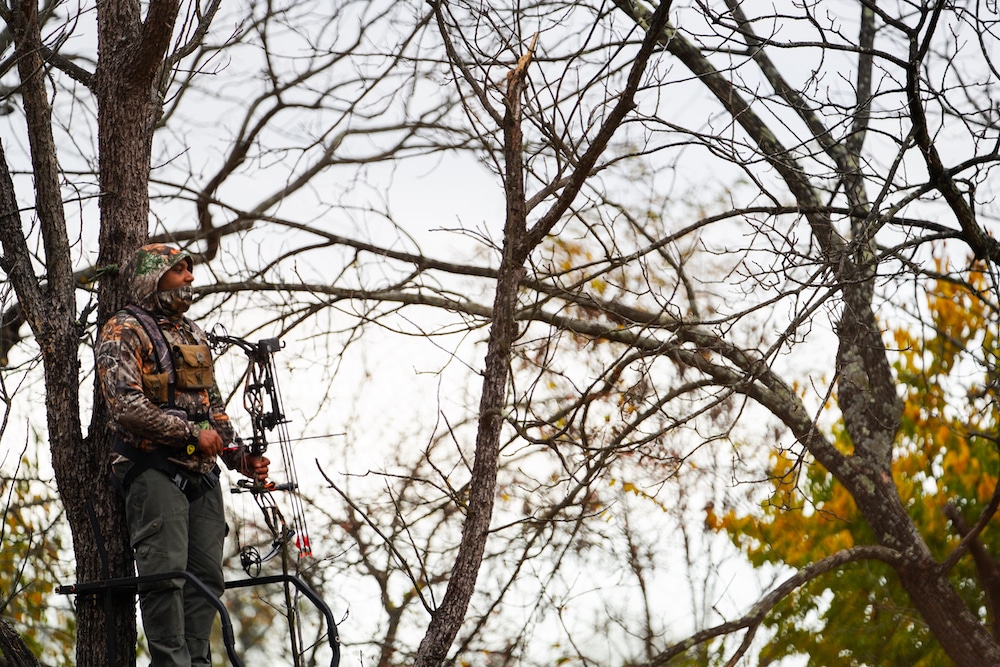Bowhunters look forward to hunting in cooler temperatures. Many hunters believe that deer movement increases when the temperatures drop. While weather doesn’t affect the timing of the rut, according to Mississippi State University, deer may become more active, and therefore more visible, or change their movement patterns based on weather systems. For mule deer, snow might drive them out of their summer range in the mountains. And elk hunters love a fresh snow, as it makes it easier to track down elk in their beds.
When cold weather hits, it’s time to head to the woods. However, as the weather changes, so should some of your hunting strategies.
Checking the forecast is an essential part of a hunt plan. Understanding what’s expected from the weather helps you be prepared. You’ll know what clothing to wear, what driving conditions to expect and if there’s anything potentially dangerous on the way like a blizzard or extreme winds.
It’s important to check the forecast daily, as conditions can change fast. If you’re in the backcountry, always have the latest weather updates. Most satellite communication devices have a way to check the forecast. You can also have friends or family members keep an eye on the weather and send reports.
Hunting in cold weather requires the right gear, especially on your body. Not only do you want to be comfortable for the temperature, but you need to be safe. That’s why wearing the proper layering system is essential. A layering system manages heat retention. It’s critical to wear clothing that keeps your body warm enough yet prevents you from being too warm. With a layering system, you add or subtract layers based on your activity level, body temperature and outside conditions.
The type of fabric and insulation matters. For example, many hunters know the popular saying, “cotton kills.” Cotton absorbs sweat and takes a long time to dry, which makes it dangerous to wear in cold weather against the skin because it keeps you cold. The next-to-skin layer should be wool or some type of quick-drying synthetic fabric.
Always be prepared for any weather. Cold weather can be especially dangerous without proper planning and gear. Always carry some basic survival gear. Bring a lighter and fire starter. Pack accessories like a hat and gloves. Rain gear is always a good idea. Have a dry set of clothes in your truck in case you get wet. Take along a basic medical kit. A lightweight tarp can serve as a shelter. Always have a way to communicate. If you have cellphone service, bring a fully charged phone. If you won’t have service, carry a satellite communication device. It doesn’t hurt to bring a portable battery with a charging cord. A headlamp is also a necessity. While this all might seem like extra weight in your pack, being prepared can save your life.

Make sure you draw your bow every so often to keep your muscles warmed up. Photo Credit: Bowhunters United
The following has happened to more than a few hunters: You spend hours sitting and shivering in the treestand. Suddenly, a buck makes an appearance in your shooting lane. All your patience is about to pay off. But when you go to draw back your bow, it won’t budge. You try again. Nothing. The buck walks off and you walk away empty-handed, wondering what happened.
Cold weather affects muscles in a big way. Sitting for too long in the cold stiffens muscles. You suddenly try to draw your bow, and it seems impossible. If your bow is already hard to draw in normal conditions, this is something you need to think about ahead of time. To prevent this mistake, make sure your bow isn’t set up with too much draw weight.
Keep your muscles warmed up. Draw your bow at least once an hour in the stand. Move the rest of your muscles too. Some archers alternate between sitting and standing. Some do stretches. Movement keeps your muscles warm. Just be sure to slowly look around before making any big movements, so you don’t scare away deer.
Winter weather can offer some of the best bowhunting opportunities. However, it can also be dangerous. It’s important to strike the right balance between getting out and knowing your limits. Sometimes weather should force you to adjust your plans. Even the most prepared hunter can wind up in a dangerous situation in the wrong conditions. Avoid putting yourself, your hunting partners, and search and rescue crews at risk.
Be aware of dangerous weather like blizzards and subzero temperatures. Reconsider driving in treacherous conditions like whiteouts and on slick roads. Even if you have only a short walk to the stand, you can get into trouble. A good hunt plan involves letting people know where you will be and when to expect you home, especially if you’re out alone. This is critical in bad weather. You can never check in too frequently during rough conditions. Don’t feel bad about sitting home on bad weather days. Sometimes hunting immediately before or after the storm provides the safest and best opportunities.
With the right approach, hunting in cold weather can be safe, comfortable and successful.